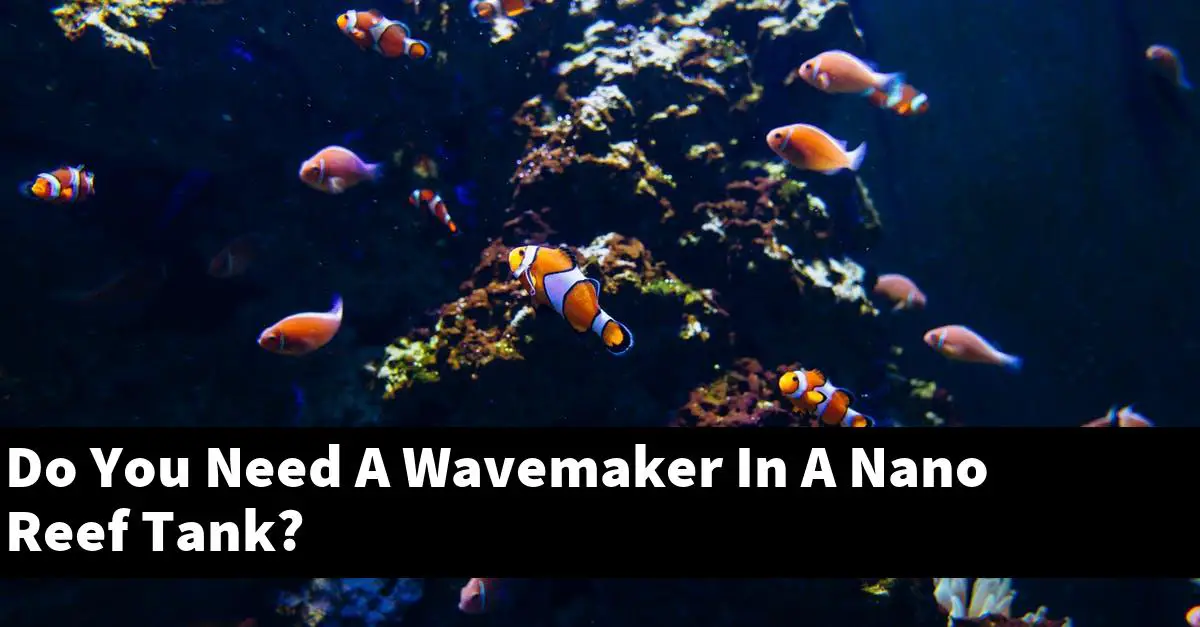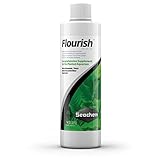A wavemaker is a device that creates water movement in an aquarium. Wavemakers can be used in both freshwater and saltwater aquariums.
In a nano reef tank, a wavemaker can be used to create water movement and circulation. There are many different types and sizes of wavemakers available on the market.
Do i need a wave maker nano reef?
Fluval Plant 3.0 LED Planted Aquarium Lighting, 32 Watts, 24-34 Inches
8% OffBoyd Enterprises CPGNnano5 Chemi-Pure Green Nano 5 Pack Aquarium Filtration
$9.54 (as of July 21, 2024 14:49 GMT +03:00 - More infoProduct prices and availability are accurate as of the date/time indicated and are subject to change. Any price and availability information displayed on [relevant Amazon Site(s), as applicable] at the time of purchase will apply to the purchase of this product.)Seachem Flourish Freshwater Plant Supplement 500 ml
22% OffA wave maker nano reef is a tool that can be used to create waves in your tank. This can help to stimulate the growth of coral and other reef organisms.
Does saltwater tank need wave maker?
A wave maker is a mechanical device that creates waves in a saltwater tank. Wave makers are used to stimulate the growth of marine organisms and to improve the aesthetics of a saltwater tank.
What to look for when buying an aquarium wave maker?
The best aquarium wave makers have a number of features that make them ideal for use in home aquariums. These features include adjustable speed and intensity, a wide range of water flow rates, and a durable construction.
When choosing an aquarium wave maker, it is important to first determine the size of the aquarium that you will be using it in. Wave makers come in a variety of sizes, from small tabletop models that can fit in a single corner of an aquarium, to models that can fit on a large stand.
Once you have determined the size of the aquarium, you can look for aquarium wave makers that have adjustable speed and intensity settings. These settings will allow you to tailor the wave maker to the needs of your specific aquarium.
Another important feature to look for when selecting an aquarium wave maker is the range of water flow rates that it offers. Wave makers come in a variety of speeds, from very slow flow rates that are perfect for smaller aquariums, to high flow rates that are suitable for larger aquariums.
It is important to find a wave maker that offers a flow rate that is appropriate for the size of your aquarium.
Another important factor to consider when purchasing an aquarium wave maker is the construction of the machine. Wave makers that are made from durable materials will last longer and be more reliable than models that are made from less durable materials.
Overall, the best aquarium wave makers have a number of features that make them ideal for use in home aquariums. These features include adjustable speed and intensity, a wide range of water flow rates, and a durable construction.
When choosing an aquarium wave maker, it is important to first determine the size of the aquarium that you will be using it in, and to look for models that have adjustable speed and intensity settings and a range of water flow rates that is appropriate for the size of your aquarium.
How do you use a wave maker on a boat?
There are a few different types of wave makers that can be used on a boat. A bow wave maker is a device that is attached to the bow of the boat and creates a wave that moves forward.
A stern wave maker is attached to the stern of the boat and creates a wave that moves aft. A wave maker can also be mounted on a pole that is raised and lowered, creating a wave that moves across the boat.
How does a reef wave maker work?
A reef wave maker (sometimes just called a “reefer”) is a device that is used to create waves in a body of water. It is a type of oceanographic instrument that is typically used to create waves in coral reef environments.
The basic principle behind a reef wave maker is that it uses a series of paddles to create a series of waves that propagate through the water. This can be done in a number of different ways, but typically a reef wave maker uses a series of paddles that are moved back and forth in a similar pattern.
This pattern of movement is what creates the waves.
The waves that are created by a reef wave maker can have a number of different properties. Some of the most common are height and amplitude.
The height of the waves can be determined by the size of the paddles that are used, while the amplitude of the waves is determined by the speed at which the paddles are moved.
The main purpose of a reef wave maker is to create waves that are beneficial for the environment. Specifically, it is used to promote the growth of coral reef organisms.
This is done by providing them with a source of waves that they can use to swim. Additionally, the waves that are created by a reef wave maker can help to stabilise the environment.
This is because they can create a barrier between the water and the sea floor.
Which is the best wave maker for a planted fish tank?
Wave makers are devices that create a wave-like motion in a water body. They are typically used in planted tanks to create a naturalistic environment for fish.
The different wave makers available range in price, features, and size. It is important to choose the right wave maker for your planted tank, as the wrong one can be frustrating and even dangerous for your fish.
Some of the factors to consider when choosing a wave maker for a planted tank are the size of the tank, the type of fish you plan to keep, and the budget. Wave makers come in different sizes, from small, handheld units to larger, more stationary units.
It is important to choose the right size for your tank. The smallest wave makers can fit tanks as small as 10 gallons, while the largest can accommodate tanks up to 150 gallons.
The type of fish you plan to keep will also influence your choice of wave maker. Some wave makers are specifically designed for fish, while others are compatible with both fish and plants.
If you plan to keep only fish, a fish-specific wave maker is the best option. If you also plan to keep plants, a plant-compatible wave maker is the best option.
The budget is also a factor to consider when choosing a wave maker. Wave makers range in price from around $20 to $100. The more features the wave maker has, the more expensive it will be.
Once you have chosen the size, type, and budget of your wave maker, the next step is to choose the type of wave maker you want. There are three main types of wave makers: electronic, mechanical, and oscillating.
Electronic wave makers use electronic circuitry to create the wave motion. They are the most advanced type of wave maker and are the only type that is compatible with both fish and plants.
They are the most expensive type of wave maker and require a power source (either an outlet or a battery) to operate.
Mechanical wave makers use a motor to create the wave motion. They are the least expensive type of wave maker and are the only type that is compatible with fish only.
They are not compatible with plants.
Oscillating wave makers use a motor and an oscillating blade to create the wave motion. They are the least expensive type of wave maker and are the only type that is compatible with both fish and plants.
They are the smallest type of wave maker and the easiest to use.
After you have chosen the size, type, and budget of your wave maker, the next step is to choose the type of wave maker you want. There are three main types of wave makers: electronic, mechanical, and oscillating.
Electronic wave makers use electronic circuitry to create the wave motion. They are the most advanced type of wave maker and are the only type that is compatible with both fish and plants.
They are the most expensive type of wave maker and require a power source (either an outlet or a battery) to operate.
Mechanical wave makers use a motor to create the wave motion. They are the least expensive type of wave maker and are the only type that is compatible with fish only.
They are not compatible with plants.
Oscillating wave makers use a motor and an oscillating blade to create the wave motion. They are the least expensive type of wave maker and are the only type that is compatible with both fish and plants.
They are the smallest type of wave maker and the easiest to use.
Where do you put a wavemaker in a nano tank?
A wavemaker is a small, electronic device that creates a waveform or pattern in a fluid or gas. It is used to create a variety of aquatic habitats, including open ocean and coral reefs.
To use a wavemaker in a nano tank, it must be securely attached to the tank’s upper or lower surface. The wavemaker will create a pattern of waves that will stimulate the growth of coral or other aquatic plants.
What equipment do i need for a nano reef tank?
In order to set up a nano reef tank, you will need the following:
-A filter
-Lighting equipment
-Reef aquarium
-Water parameters test kit
-Anemone and coral
– Coral food
-Aquarium heater
-Aquarium water filter
-Aquarium gravel
-Aquarium decor
-Aquarium salt
-Aquarium water conditioner
-Aquarium CO2
A nano reef tank is a very small tank that can be set up in just a few minutes. It is perfect for those who want to set up a reef tank but don’t have a lot of space.
You will need a filter, lighting equipment, and a reef aquarium to set up the tank. The filter will help to remove debris and pollutants from the water, and the lighting equipment will help to simulate natural sunlight.
You will also need water parameters test kit, anemone and coral, coral food, aquarium heater, aquarium water filter, aquarium gravel, aquarium decor, and aquarium salt.
Conclusion
There is some debate on whether or not you need a wavemaker in a nano reef tank. Some believe that the benefits of having one, such as increased oxygenation and circulation, are worth the extra expense.
Others believe that nano reefs are too small to benefit from a wavemaker, and that the added expense is not worth it. Ultimately, the decision of whether or not to use a wavemaker in a nano reef tank is up to the individual.





















